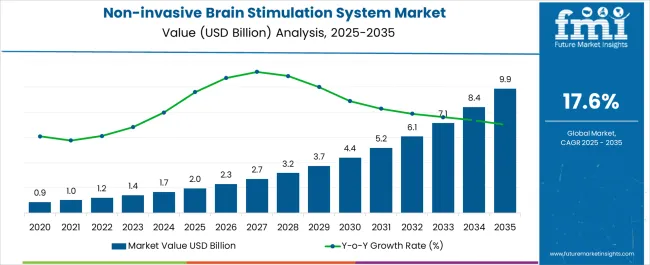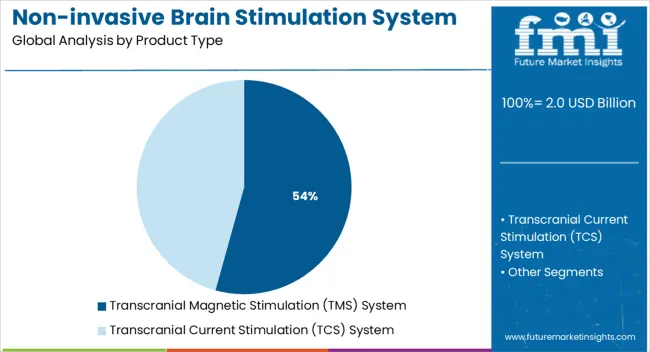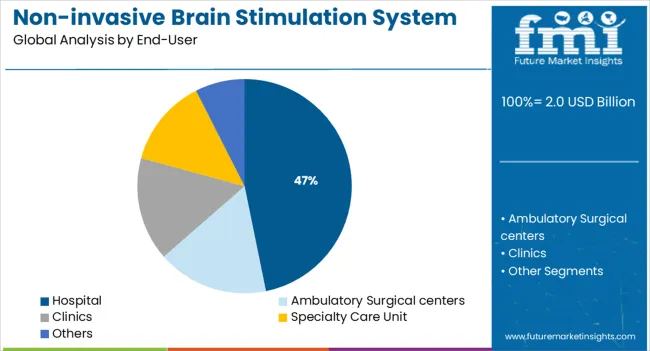The Non-invasive Brain Stimulation System Market is estimated to be valued at USD 2.0 billion in 2025 and is projected to reach USD 9.9 billion by 2035, registering a compound annual growth rate (CAGR) of 17.6% over the forecast period.

| Metric | Value |
|---|---|
| Non-invasive Brain Stimulation System Market Estimated Value in (2025 E) | USD 2.0 billion |
| Non-invasive Brain Stimulation System Market Forecast Value in (2035 F) | USD 9.9 billion |
| Forecast CAGR (2025 to 2035) | 17.6% |
The non-invasive brain stimulation system market is witnessing considerable growth, driven by rising neurological disorder prevalence, expanding clinical research in neuromodulation, and increased focus on non-pharmacological treatment alternatives. As mental health awareness surges globally, the need for advanced, non-invasive therapeutic tools for conditions like depression, Parkinson’s, and chronic pain is becoming more prominent.
Favorable regulatory shifts and growing insurance coverage for brain stimulation therapies have further supported clinical adoption. Technological innovations, such as targeted stimulation algorithms, enhanced coil precision, and integration with neuroimaging tools, have boosted treatment efficacy and user safety.
Additionally, academic collaborations and government-backed trials are accelerating the validation of new protocols, helping expand clinical indications. Moving forward, hospital infrastructure modernization and demand for outpatient neurological care are expected to drive continued uptake of non-invasive stimulation systems.
The market is segmented by Product Type and End-User and region. By Product Type, the market is divided into Transcranial Magnetic Stimulation (TMS) System and Transcranial Current Stimulation (TCS) System. In terms of End-User, the market is classified into Hospital, Ambulatory Surgical centers, Clinics, Specialty Care Unit, and Others. Regionally, the market is classified into North America, Latin America, Western Europe, Eastern Europe, Balkan & Baltic Countries, Russia & Belarus, Central Asia, East Asia, South Asia & Pacific, and the Middle East & Africa.

Transcranial magnetic stimulation (TMS) systems are projected to account for 54.3% of the total market revenue in 2025, making them the leading product type. Their dominance is being driven by strong clinical validation for depression, expanding insurance reimbursement in key markets, and favorable patient outcomes in treatment-resistant cases.
TMS offers the advantage of targeted cortical stimulation without the need for surgical intervention or anesthesia, enhancing patient compliance. Continuous improvements in coil design and stimulation precision have elevated treatment accuracy while minimizing side effects.
Integration of AI-enabled protocol customization and portable system formats has also made TMS more accessible for outpatient settings. The segment is further supported by rising research grants and FDA-cleared expansions into conditions like OCD and migraine, reinforcing its commercial and clinical viability.

Hospitals are expected to hold 46.8% of the overall market revenue in 2025, positioning them as the dominant end-user segment. This leadership is supported by the availability of advanced neurology departments, trained personnel, and comprehensive diagnostic infrastructure required for non-invasive stimulation therapies.
Hospitals serve as primary centers for the administration of TMS and related therapies, especially for patients with severe or treatment-resistant conditions. Greater funding for neurological units and the integration of digital health records have facilitated broader adoption and clinical monitoring.
In addition, hospitals often participate in multicenter clinical trials, giving them early access to next-generation stimulation technologies. Their role in acute care and post-discharge neurological rehabilitation further strengthens their position as key facilitators of non-invasive brain stimulation therapy delivery.
The market for non-invasive brain stimulation systems is predicted to see growth due to an increase in the number of persons suffering from neurological illnesses in key regions of the world. Neurological problems are becoming more common as the geriatric population worldwide goes up. This is driving up demand for non-invasive brain stimulation systems, which is, in turn, driving up market expansion.
Governments of many developed and developing countries provide enticing reimbursement plans for healthcare institutions. The non-invasive brain stimulation system market is growing in terms of sales based on this ground as well.
The function of the brain is investigated using functional MRI (magnetic resonance imaging) and EEG (electroencephalogram) methods. The process of stimulating the brain is also used to promote mental activity. The two techniques for brain stimulation are repeated transcranial magnetic stimulation (TMS) and transcranial current stimulation (TCS).
These two procedures, which are collectively referred to as non-invasive brain stimulation, are used to both enhance brain function and disrupt brain activity. Over the forecast period, the increasing relevance of these techniques is anticipated to encourage the growth of the worldwide non-invasive brain stimulation system market.
The industry's leading companies are concentrating on getting new non-invasive brain stimulation systems approved and put on the market in order to increase the variety of products they provide.
In addition, major industry competitors are concentrating on releasing improved versions of their non-invasive brain stimulation systems in the market. The industry is anticipated to increase as new technologies are increasingly used by hospitals.
The hazards associated with deep brain stimulation treatments, such as lead misplacement and brain haemorrhage, are one of the main reasons impeding the growth of the global non-invasive brain stimulation system market. The risk of infections brought on by IPG is expected to limit the adoption of a Non-invasive Brain Stimulation System for Parkinson's disease.
On the other hand, another major restraint concerning the non-invasive brain stimulation systems market during the forecast period is likely to be electroconvulsive therapy. It has clinically demonstrated high efficacy in treating psychotic depression, and the number of patients utilizing the therapy is extremely high.
North America is predicted to dominate the global non-invasive brain stimulation systems market during the forecast period holding nearly 34.6% market share in 2025. a sizable population with depression and other neurological and psychological disorders, the presence of cutting-edge healthcare infrastructure and technologies, the availability of integrated healthcare IT products to maintain electronic health records, investments by governments in the creation of revolutionary medical devices, the availability of skilled and trained professionals, favorable reimbursement policies, and an increase in the adoption of advanced products are all contributing to the market growth in the region.
Statistics from the Centers for Disease Control and Prevention (CDC) show that between 3.5 million and 4 million persons in the United States of America alone have depression that is resistant to therapy.
In order to enhance equipment and technology and broaden the range of uses for non-invasive brain stimulation systems, there has been an increase in partnerships and cooperation between businesses and research universities on the international market. The market participants operating in the region have several prospects as a result of this and the rising number of approvals.

The second-largest market after the United States of America, Europe has had tremendous economic growth and increased healthcare access which resulted in the region holding almost 31.7% market share.
This has created a market opportunity for producers of innovative and non-invasive devices. During the forecast period, factors such as rising psychological disorder occurrence, rising health care spending, rising government initiatives, rising Research and Development activities, rising medical tourism, and rising demand for new treatments for these disorders are anticipated to support the growth of the non-invasive brain stimulation system market in Europe.
The therapeutic potential of brain stimulation in the treatment of brain-related illnesses is currently being researched by new entrants.
For instance, LivaNova and MicroPort Scientific got FDA clearance for RegaTM pacemakers in September 2020. On the other hand, OrbiMed Advisors and KCK Groups launched an investment round of USD 74 million that NeuroPace, Inc. concluded last October.
With the help of this finance, the business will be able to quickly develop and market its FDA-approved DBS product, the NeuroPace RNS system.
Numerous companies in the non-invasive brain stimulation system market are introducing novel, transportable, user-friendly, affordable, and highly effective products. Furthermore, a lot of businesses are concentrating on commercializing their offerings.
Example:
| Report Attribute | Details |
|---|---|
| Growth Rate | CAGR of 6.6% from 2025 to 2035 |
| Base Year for Estimation | 2024 |
| Historical Data | 2020 to 2024 |
| Forecast Period | 2025 to 2035 |
| Quantitative Units | Revenue in USD Billion, Volume in Kilotons, and CAGR from 2025 to 2035 |
| Report Coverage | Revenue Forecast, Volume Forecast, Company Ranking, Competitive Landscape, Growth Factors, Trends, and Pricing Analysis |
| Segments Covered |
Product Type, Application, End-user, Region |
| Regions Covered |
North America; Latin America; The Asia Pacific; Middle East and Africa; Europe |
| Key Countries Profiled |
USA, Canada, Brazil, Argentina, Germany, United Kingdom, France, Spain, Italy, Nordics, BENELUX, Australia & New Zealand, China, India, ASEAN, GCC Countries, South Africa |
| Key Companies Profiled |
NeoSync, Inc.; Highland Instruments; MagVenture; BrainsWay; Magstim |
| Customization | Available Upon Request |
The global non-invasive brain stimulation system market is estimated to be valued at USD 2.0 billion in 2025.
The market size for the non-invasive brain stimulation system market is projected to reach USD 9.9 billion by 2035.
The non-invasive brain stimulation system market is expected to grow at a 17.6% CAGR between 2025 and 2035.
The key product types in non-invasive brain stimulation system market are transcranial magnetic stimulation (tms) system and transcranial current stimulation (tcs) system.
In terms of end-user, hospital segment to command 46.8% share in the non-invasive brain stimulation system market in 2025.






Full Research Suite comprises of:
Market outlook & trends analysis
Interviews & case studies
Strategic recommendations
Vendor profiles & capabilities analysis
5-year forecasts
8 regions and 60+ country-level data splits
Market segment data splits
12 months of continuous data updates
DELIVERED AS:
PDF EXCEL ONLINE
Brain Monitoring Market Size and Share Forecast Outlook 2025 to 2035
Brain Fitness Market Size and Share Forecast Outlook 2025 to 2035
Brain Computing Interfaces Market Size and Share Forecast Outlook 2025 to 2035
Brain Cancer Diagnostics Market Size and Share Forecast Outlook 2025 to 2035
Brain Metastasis Therapeutics Market Analysis - Size, Share, and Forecast Outlook 2025 to 2035
Brain-Computer Interface Implant Market Analysis Size and Share Forecast Outlook 2025 to 2035
Brain Implants Market Size and Share Forecast Outlook 2025 to 2035
Brain Imaging and Neuroimaging Market Size and Share Forecast Outlook 2025 to 2035
Brain Health Supplement Market Analysis - Size, Share, and Forecast Outlook 2025 to 2035
Brain Tumor Treatment Market Analysis-- Size and Share Forecast Outlook 2025 to 2035
Brain Biomarker Market Trends and Forecast 2025 to 2035
Brain Tumor Drugs Market Forecast & Analysis: 2025 to 2035
Brain Mint Market Analysis by Functionality, Consumer Orientation, Sales Channel and Region Through 2035
Brain Fingerprinting Technology Market
Brain Monitoring Systems Market is segmented by Lateral Flow Readers and Kits and Reagents from 2025 to 2035
Deep Brain Stimulator Market Size and Share Forecast Outlook 2025 to 2035
Kids’ Brain Health Supplements Market Size and Share Forecast Outlook 2025 to 2035
Bovine Brain Extract Size and Share Forecast Outlook 2025 to 2035
Chronic Brain Damage Treatment: Trends, Growth, and Key Developments
Auditory Brainstem Response Analyzers Market Size and Share Forecast Outlook 2025 to 2035

Thank you!
You will receive an email from our Business Development Manager. Please be sure to check your SPAM/JUNK folder too.
Chat With
MaRIA